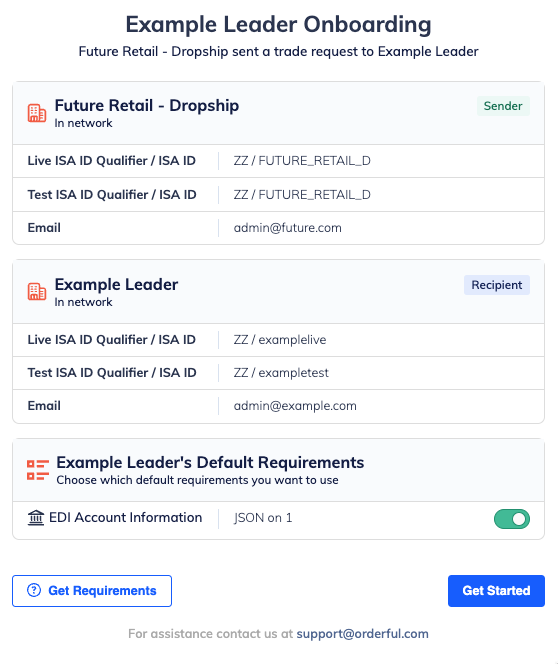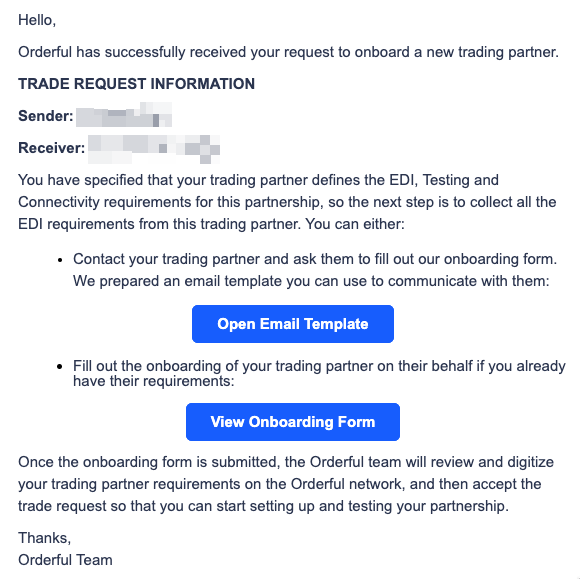2. Set up a Trading Partnership as a Follower
A Trading Partnership is a relation between two EDI Accounts that contains at least one Relationship. If you are a Follower who wants to trade EDI documents with a Leader, you must create a new Trading Partnership by sending a Trade Request to your Leader.
To create a new Trading Partnership as a Follower, you will need to:
- Accept or create a Trade Request.
- (Only for Unclaimed Leaders) Gather your Trading Partner's requirements.
- Configure your Relationship
2.1 Accept or Create a Trade Request
First you will need to start a new Partnership by accepting an existing Trade Request or sending a new one.
To accept an existing Trade Request:
- Go to your Trade Requests settings.
- Click on an entry under "Inbound Requests". This will open a sidebar on the right with further information about the Trade Request.
- Click Accept.
Alternatively, you may have to create a new Trade Request.
Automated Onboarding for Leaders with Default RequirementsIf your Leader already has defaults configured in the Orderful network, you can find them:
- Go to your Trade Requests settings.
- Click on Create Trade Request.
- Fill out the form that pops up. Since you are the Follower, be sure to select "My trading partner (I am the Follower).
- You can look up your Leader's Company Name. If their name comes up as "In our network" that means that they have default requirements configured in the Orderful network and you will be able to skip some or all of the following steps.
You will first need the following information from your Partner:
- ISA or EDIFACT ID
- ISA or EDIFACT Qualifier
- Contact email
Orderful will use the ISA ID to look up whether we already have this company and its requirements in our system.
An example email template requesting this information can be found here: Trade Request information email template
Once you have these you can create the Trade Request:
- Go to your Trade Requests settings.
- Click on Create Trade Request.
- Fill out the form that pops up. Since you are the Follower, be sure to select "My trading partner (I am the Follower).
- You can look up your Leader's Company Name.
- If the Company Name is in our network: This means that we have this Leader in our network and have some or all of their requirements already configured. This means that some or all of the information required in the following steps will be prepopulated for you, which means you will not need to get this from your Trading Partner.
- If the Company Name is not found: This means that we do not have this Leader in our network. Proceed through the rest of these steps as normal.
- Once completed, you will be redirected to our onboarding form which you can follow to enter your Leader’s requirements. You will also receive an email from Orderful that will contain a link to this form.

If you know your Leader's requirements, you can enter them here. Otherwise, you will have to gather their requirements.
2.2 Gather requirements
If you are a Follower sending a Trade Request to an Unclaimed Leader, you will need to gather their document trading requirements. You can gather these requirements from your Leader in any way you like. For convenience, we will send you both an email template that you can fill out and send to your Leader as well as a form to enter their requirements:

If you received a Trade Request from a claimed Leader who is already in our system, you can skip this step.
Once the information is submitted, the Orderful team will review your Trade Request and either:
- Get in touch for follow-up if there are requirements that are missing, incomplete or inaccurate.
- Accept your trade request and configure the relationships on your Trading Partner’s side. You are now ready to start configuring and testing your relationships.
Once the request is accepted its validation status will be updated to "Accepted", however it will only be visible if you check "Show hidden" on the upper right of the Trade Requests page.
2.3 Configure your Relationship
Now that your Trade Request has been accepted, you will have one or more new Relationships visible in your Relationship settings.
You will have one Relationship for each Transaction Type that your Leader has defined in their scenarios.
Until the required information is submitted, the status of the Relationship will remain as "Pending setup by partner".
Relationship StatusIf you'd like to see a breakdown of all the different Relationship statuses and what they mean, they are documented here: Relationship statuses
Once Orderful has configured your Partner’s end of the Relationship, the status will change to "Configure setup". You will receive an email when this happens. At this point you can select the Relationship and configure the following:
- Data format: The data format of the document you will send or receive.
- EDIFACT Syntax Version (EDIFACT only)
- EDIFACT Character Set (EDIFACT only)
- Version: (e.g. 4010).
- Guideline
- Communication Channel: (Inbound only) Choose one or more Communication Channels for transactions you receive in the Live and Test stream.
- For each Communication Channel, you can configure Advanced Delivery Settings to choose delivery conditions or format the transaction being sent.
- If the type of Communication Channel you selected isn’t compatible with your Relationship data format and version, you’ll need to configure conversion options under Advanced Delivery Settings.
- If you want to receive transactions in both Test and Live streams on the same Communication Channel, you can tick the checkbox "Use selected for Test Communication Channel".
- Deliver acknowledgements (Outbound only) If the Data Format is X12 or EDIFACT, you can select this checkbox to receive 997 (for X12) or CONTRL (for EDIFACT) Functional Acknowledgements.
- If you choose to receive Functional Acknowledgements, you must then choose a Live Communication Channel for acknowledgments received for transactions in the Live and Test stream.
- If you want to receive Functional Acknowledgments for transactions in both Test and Live streams on the same Communication Channel, you can tick the checkbox "Use selected for Test Communication Channel".
- Timeout Time: (Outbound only) Defines how long you want to wait for a Functional Acknowledgment from your partner before a transaction is set as "Overdue".
Updated about 1 month ago
